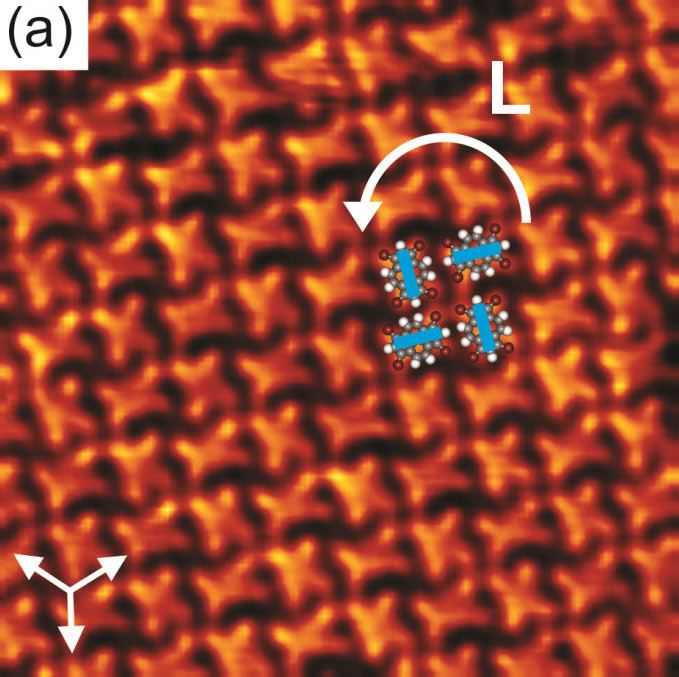 | ||
Molecular self-assembly is the process by which molecules adopt a defined arrangement without guidance or management from an outside source. There are two types of self-assembly. These are intramolecular self-assembly and intermolecular self-assembly. Commonly, the term molecular self-assembly refers to intermolecular self-assembly, while the intramolecular analog is more commonly called folding.
Contents
Supramolecular systems
Molecular self-assembly is a key concept in supramolecular chemistry. This is because assembly of molecules in such systems is directed through noncovalent interactions (e.g., hydrogen bonding, metal coordination, hydrophobic forces, van der Waals forces, π-π interactions, and/or electrostatic) as well as electromagnetic interactions. Common examples include the formation of micelles, vesicles, liquid crystal phases, and Langmuir monolayers by surfactant molecules. Further examples of supramolecular assemblies demonstrate that a variety of different shapes and sizes can be obtained using molecular self-assembly.
Molecular self-assembly allows the construction of challenging molecular topologies. One example is Borromean rings, interlocking rings wherein removal of one ring unlocks each of the other rings. DNA has been used to prepare a molecular analog of Borromean rings. More recently, a similar structure has been prepared using non-biological building blocks. While a mechanistic understanding of how supramolecular self-assembly occurs remains largely unknown, both experimental and theoretic work has been pursued on this topic.
Biological systems
Molecular self-assembly underlies the construction of biologic macromolecular assemblies in living organisms, and so is crucial to the function of cells. It is exhibited in the self-assembly of lipids to form the membrane, the formation of double helical DNA through hydrogen bonding of the individual strands, and the assembly of proteins to form quaternary structures. Molecular self-assembly of incorrectly folded proteins into insoluble amyloid fibers is responsible for infectious prion-related neurodegenerative diseases. Molecular self-assembly of nanoscale structures plays a role in the growth of the remarkable β-keratin lamellae/setae/spatulae structures used to give geckos the ability to climb walls and adhere to ceilings and rock overhangs.
Nanotechnology
Molecular self-assembly is an important aspect of bottom-up approaches to nanotechnology. Using molecular self-assembly the final (desired) structure is programmed in the shape and functional groups of the molecules. Self-assembly is referred to as a 'bottom-up' manufacturing technique in contrast to a 'top-down' technique such as lithography where the desired final structure is carved from a larger block of matter. In the speculative vision of molecular nanotechnology, microchips of the future might be made by molecular self-assembly. An advantage to constructing nanostructure using molecular self-assembly for biological materials is that they will degrade back into individual molecules that can be broken down by the body.
DNA nanotechnology
DNA nanotechnology is an area of current research that uses the bottom-up, self-assembly approach for nanotechnological goals. DNA nanotechnology uses the unique molecular recognition properties of DNA and other nucleic acids to create self-assembling branched DNA complexes with useful properties. DNA is thus used as a structural material rather than as a carrier of biological information, to make structures such as complex 2D and 3D lattices (both tile-based as well as using the "DNA origami" method) and three-dimensional structures in the shapes of polyhedra. These DNA structures have also been used as templates in the assembly of other molecules such as gold nanoparticles and streptavidin proteins.
Two-dimensional monolayers
The spontaneous assembly of a single layer of molecules at interfaces is usually referred to as two-dimensional self-assembly. Early direct proofs showing that molecules can assembly into higher-order architectures at solid interfaces came with the development of scanning tunneling microscopy and shortly thereafter. Eventually two strategies became popular for the self-assembly of 2D architectures, namely self-assembly following ultra-high-vacuum deposition and annealing and self-assembly at the solid-liquid interface. The design of molecules and conditions leading to the formation of highly-crystalline architectures is considered today a form of 2D crystal engineering at the nanoscopic scale.
